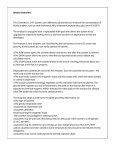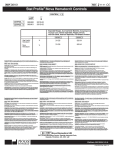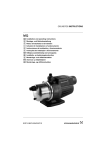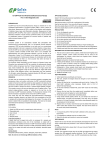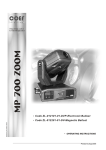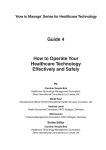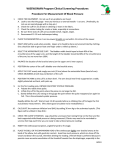Download hs-CRP - Drug testing supplies from CLIA waived,Inc, drug tests
Transcript
concentration. But this is achieved at the expense of sensitivity to detect low level increases due to more subtle causes of inflammation. • • hs-CRP High Sensitivity C-Reactive Protein Test Cassette 12-807 *402~12786* One or more of the following patents may apply: U.S. Patents 4,477,575, 4,816,224 and 5,110,724. 3347 Investment Blvd. Hayward, CA 94545 U.S.A. Tel 1.800.733.0404 Fax 1.510.732.7227 www.cholestech.com Authorized Representative AR-MED Ltd Runnymede Malthouse Egham TW20 9BD United Kingdom The Cholestech LDX System is a desk-top analyzer that utilizes dry chemistry cassettes and reflectance photometry to quantify substances in blood. Samples used for testing can be whole blood from a fingerstick (collected in a lithium heparin coated capillary tube), serum, or anticoagulated whole blood collected by venipuncture. The sample is applied to a Cholestech LDX hs-CRP cassette. The cassette is then placed into the Cholestech LDX Analyzer where a unique system on the cassette separates the plasma from the blood cells. Plasma is then incubated with a colloidal gold anti-CRP conjugate. A lateral flow system transfers the gold conjugate through an anti-CRP antibody capture zone. Gold conjugate containing CRP is captured by the antibody while the rest of the gold conjugate is washed away. The signal in the capture zone is measured by the Cholestech LDX Analyzer. A brown (magnetic) stripe on each cassette contains the calibration information required for the Cholestech LDX Analyzer to convert the reflectance reading (% R) to hs-CRP concentration in mg/L. hs-CRP Each hs-CRP Cassette contains: CRP antibody gold conjugate CRP Antibody Nonreactive Ingredients: buffers and stabilizers Refer to the CD in the analyzer package for instructions in English. The instructions are available from your local distributor. Titered Titered For in vitro diagnostic use only. Cassette Storage and Stability Le CD contenu dans l'emballage de l'analyseur inclut les directives d'utilisation en français. Le mode d'emploi est disponible auprès du distributeur local. Cassettes must be stored in the sealed foil pouches. Anweisungen auf Deutsch befinden sich auf der CD in der Verpackung des Analysegeräts. Die Anleitung ist von Ihrem Händler erhältlich. Cassettes may be used until the date printed on the pouch when stored in a refrigerator (36 – 46ºF / 2– 8ºC). Or the cassettes may be stored for up to 30 days at room temperature (less than 86°F / 30°C). Fare riferimento al CD nella confezione dell'analizzatore per istruzioni in italiano. Le istruzioni sono disponibili presso il distributore di zona. Consulte el CD incluido en el envase del analizador para obtener instrucciones en español. También puede pedir las instrucciones a su distribuidor local. • PRECAUTION: All blood samples, containers, capillary tubes and materials that have come in contact with whole blood, serum, or plasma should be handled as if capable of transmitting infectious disease and discarded into a biohazardous waste container after use. NOTE: Fingerstick samples must be applied within five (5) minutes after collection or the blood may clot. 8. An Optics Check should be run on the Cholestech LDX Analyzer each day before patient samples are tested. See the Cholestech LDX User Manual for instructions. 7. TEST PROCEDURE 8. Materials Provided: hs-CRP Cassette Additional Materials Required: Cholestech LDX Analyzer and power supply • • Alcohol swabs and gauze for cleaning puncture site • Lancets for capillary blood collection • Cholestech LDX 50 µL Capillary Tubes (with lithium heparin anticoagulant only) • Cholestech LDX Capillary Plungers • Latex Gloves • Biohazard waste containers • Quality Control material • Cholestech MiniPet Pipette and tips, or micropipetter that will deliver 50 µL for use with whole blood venipuncture samples and 40 µL for use with serum, plasma and Quality Control material • Vacuum collection tubes, needles, tube holders and sample tubes, if the sample is to be collected by venipuncture 1. 2. 3. Once cassettes have been stored at room temperature, they should not be returned to the refrigerator. Se CD:n i analysatorförpackningen beträffande instruktioner på svenska. Instruktionerna finns att få hos din lokala återförsäljare. Cassette Handling Cassettes should sit at room temperature for 10 minutes before opening the pouch. Use the cassette as soon as the pouch is opened. 4. INTRODUCTION 9. Discard everything that contacted the blood sample or Quality Control material into a biohazardous waste container. 10. When the test is complete, the Analyzer will beep. The display screen will read: Sample Requirement 11. When the results are outside the measuring range, the screen will read: hs-CRP < 0.30 Sample Volume: 50 µL of whole blood, or 40 µL of serum or plasma. Serum hs-CRP < 0.30 or or hs-CRP >10.0 hs-CRP > 8.00 12. If there is a problem with the test, an error message will appear on the screen. See the Troubleshooting section of the Cholestech LDX User Manual for additional information. Please call Cholestech Technical Service at 1.800.733.0404 or 1.510.732.7200 if you have any questions about the Cholestech LDX System. Press RUN. In a few seconds the screen will read: Selftest running. 13. When the drawer opens, remove the cassette. Discard into a biohazardous waste container. Leave the Cholestech LDX Analyzer drawer empty when not in use. 14. Record the hs-CRP results. 15. To run another cassette, press RUN. The screen will read: Fingerstick whole blood: • • • Collect the sample from a fingerstick into a 50 µL Cholestech Capillary Tube. (See the Fingerstick Procedure below). Place the blood into the cassette within 5 minutes after collection. Blood from the fingerstick should flow freely into the capillary tube. Too much squeezing of the finger may produce inaccurate results. The cassette drawer will open. The screen will read: Venous whole blood: CRP is an acute phase reactant that responds as a sensitive, though nonspecific, marker of systemic inflammation. The pentameric, globular protein is synthesized by the liver in response to stimuli from circulating inflammatory cytokines. CRP has traditionally been used as a systemic marker of infection and tissue injury.1 An expanding body of research now indicates that CRP likely plays a direct, active inflammatory role in blood vessels, leading to the development of atherosclerosis.2 • Within 24–48 hours of an infectious or noninfectious stimulus, CRP levels may rise up to 3,000-fold over the circulating levels seen in apparently healthy individuals, which is typically less than 10 mg/L.1 CRP levels in conditions characterized by chronic inflammation, such as rheumatoid arthritis and certain other rheumatic disorders, are likewise characterized by significant elevations. Conventional CRP assays have therefore been optimized to facilitate measurement of dynamic increases in • Collect blood into a green top tube (lithium or sodium heparin anticoagulant) or a serum tube without additives. Load cassette and press RUN Selftest OK 5. 16. Repeat the test procedure. 17. Otherwise, after 4 minutes of inactivity, a beep will sound and the display screen will read: Load cassette and press RUN System timeout RUN to continue NOTE: Do not use a tube with any other additives because it may cause inaccurate results. • • • • Whole blood should be used within thirty minutes. Blood sample may be taken directly from the tube after mixing. Serum samples should be allowed to clot for 30 minutes. Serum should be separated from the blood cells immediately, and stored refrigerated in a tightly sealed sample tube at 2-8°C (36-46°F) until testing is performed. Samples should be at room temperature before testing. Mix all samples by inverting gently 7-8 times before testing. Do not use the Cholestech capillary tubes for measuring venous whole blood or serum. Hold the capillary tube horizontally by the end with the plunger. Touch the end of the tube to the drop of blood without touching the skin. The tube will fill by capillary action to the black mark. Do not collect air bubbles. If it is necessary to collect another drop of blood, massage the finger again from base to tip. NOTE: A warm hand and good blood flow from the puncture site are essential in order to collect a good capillary sample. Fill the capillary tube in under 10 seconds.. Using the Cholestech MiniPet Pipettes hs-CRP=### NOTE: Gloves should be worn whenever working with blood samples that are potentially biohazardous. NOTE: When running a fingerstick or venous whole blood, the configuration menu must be set for whole blood. When running serum or plasma, quality control or proficiency testing material, the configuration menu must be set for “serum”. See Setting the Configuration Menu in the Cholestech LDX System User Manual. Choose a spot that is on the side of one of the center fingers of either hand. The fingers and hands should be warm to the touch. To warm the hand, you can: a. Wash the patient’s hand with warm water, or... b. Apply a warm (not hot) compress to the hand for several minutes, or... c. Gently massage the finger from the base to the tip several times to bring the blood to the fingertip. Clean the site with an alcohol swab. Dry thoroughly before pricking the finger. Firmly prick the selected site with a lancet. Squeeze the finger gently to obtain a large drop of blood. Wipe away this first drop of blood as it may contain tissue fluid. Squeeze the finger gently again while holding it downward until a second large drop of blood forms. Do not milk the finger. The puncture should provide a free flowing drop of blood. Use this procedure to apply a venous sample, control sample or proficiency testing material to the cassette. Use a 50 µL MiniPet Pipette for venous whole blood. Use a 40 µL MiniPet Pipette for serum, controls samples or proficiency testing material. Any pipette that can accurately deliver the correct volume may also be used. 1. Firmly attach the pipette tip to the end of the MiniPet Pipette. 2. To fill the pipette, push the plunger down as far as you can. Place the pipette tip into the sample and slowly release the plunger. Do not allow air to be drawn into the tip. 3. Dispense the sample into the cassette sample well by pressing the plunger again. Move the pipette tip out of the sample well before releasing the plunger. 4. Remove the pipette tip and throw it away in a biohazardous waste container. hs-CRP Running*** Remove the cassette pouch from the refrigerator. Let the cassette pouch sit at room temperature for a minimum of 10 minutes. Remove the cassette from its pouch. Hold the cassette by the short sides only. Do not touch the black bar or the magnetic stripe. Place the cassette on a clean, hard, flat surface. • Do not use a cassette beyond the printed expiration date. Do not use a cassette that has been stored at room temperature for more than 30 days. Do not reuse cassettes. Keep the cassette flat after the sample has been applied. Place the cassette into the drawer of the Analyzer immediately. The black bar must face the Analyzer. The magnetic stripe must be on the right. Immediately Press RUN. The drawer will close. During the test the display screen will read: Fingerstick or Whole Blood Der henvises til den vedlagte CD i analysatorpakken for instruktioner på dansk. Instruktionerne fås hos den lokale forhandler. Cholestech LDX high sensitivity C-Reactive Protein (hs-CRP) is an in vitro diagnostic test for the quantitative determination of C-reactive protein in whole blood or serum. Measurement of CRP is useful as an aid in the detection and evaluation of infection, tissue injury, inflammatory disorders, and associated diseases. 4. 5. 6. No calibration is performed by the user. Test information is encoded on the brown magnetic stripe of the cassette. The magnetic stripe is read by the Cholestech LDX Analyzer each time a cassette is run. • • INTENDED USE 3. 7. Running a Test • Place the sample into the cassette’s sample well. Use a Cholestech LDX 50 µL Capillary Tube for fingerstick samples. Use the Cholestech 50µL MiniPet Pipette for venous whole blood; use the Cholestech 40µL MiniPet Pipette for serum, plasma, Quality Control material and proficiency testing material. NOTE: Do not touch the white material at the end of the sample well with the tip of the capillary tube or pipette. Consulte o CD no pacote do analisador para instruções em Português. As instruções estão disponíveis junto do seu distribuidor local. ∞Ó·ÙÚ¤ÍÙ ÛÙÔ CD ÛÙË Û˘Û΢·Û›· ÙÔ˘ ·Ó·Ï˘Ù‹ ÁÈ· Ô‰ËÁ›Â˜ ÛÙ· ∂ÏÏËÓÈο. √È Ô‰ËÁ›Â˜ Â›Ó·È ‰È·ı¤ÛÈ̘ ·ðfi ÙÔÓ ÙÔðÈÎfi ‰È·ÓÔ̤· Û·˜. 6. Calibration TEST PRINCIPLE For professional in vitro diagnostic use. Cholestech LDX is a registered trademark of Cholestech Corporation. MiniPet is a trademark of TriContinent Scientific, Inc. © 2005 Cholestech Corporation. 402 12786 REV B Low level increases in CRP have been reported in various conditions and disease states that are thought to be associated with inflammation.3-6 The most prominently studied utility has been for cardiovascular disease, where CRP has been reported to predict cardiovascular outcomes independently of other conventional markers of risk.4,7,8 Increases in CRP are nonspecific, however, and should be interpreted in the context of a complete clinical evaluation. Elevated values observed in an apparently healthy individual should be repeated in order to help rule out a recent response to undetected infection or tissue injury.8 Use a Cholestech LDX 50 µL MiniPet™ Pipette and tips, or a micropipetter that is calibrated to deliver 50 µL, to place whole blood into the cassette. Use a Cholestech LDX 40 µL MiniPet Pipette and tips, or a micropipetter that is calibrated to deliver 40 µL, to place serum or plasma into the cassette. Serum or plasma samples may be stored for at least 7 days at 2-8°C.9 Serum or plasma samples should be stored frozen if they are to be kept for longer. If the RUN button is not pushed within 15 seconds the drawer will close and the display screen will be blank. Fingerstick Procedure 1. The patient should sit quietly for five minutes before the blood sample is collected. 2. Put a capillary plunger into the end of a Cholestech capillary tube with the green mark. Set aside. NOTE: 1. Keep the cassette horizontal at all times after applying the sample. 2. If the plunger is released before the pipette tip is out of the sample well, it will remove the sample just dispensed. QUALITY CONTROL Quality Control should be run routinely to confirm that your Cholestech LDX System is giving accurate results. We recommend the following Quality Control procedures for the Cholestech LDX System. Choice of Materials A high and a low control is preferred. Cholestech branded controls work well with the Cholestech LDX System. If you use other controls, you will need to establish ranges for the Cholestech LDX System. Handling • • • • • Follow the instructions that are included with your controls. Check the expiration date before use. Do not use expired controls. Use a 40 µL pipette. Run the Cholestech LDX System in “Serum” mode (see “Setting the Configuration Menu” in the Cholestech LDX System User Manual). See “Running a Test” above for the procedure. NOTE: If you will be running fingerstick or whole blood samples after you have tested Quality Control materials, be sure to change the sample type in the configuration menu to “whole blood” mode prior to running the fingerstick or whole blood samples. External Quality Control External controls must also be used to demonstrate that the reagents and assay procedure perform properly. Level 1 and Level 2 Controls containing CRP are available from Cholestech. Controls must be tested: • with each new shipment of cassettes (even if cassettes are from the same lot previously received • with each lot of cassettes received • as required by your laboratory’s standard Quality Control procedures • each day that patient samples are tested • if your local or state regulations require more frequent testing of Quality Control material Good Laboratory Practice principles suggest that external controls must be run whenever the laboratory director has any question about test system integrity or operator technique (e.g., when reagents may have been stored or handled in a way that can degrade their performance or when operators have not performed a particular test in recent weeks). If the controls do not perform as expected, repeat the test or contact Cholestech Technical Service prior to testing patient samples. The Quality Control results should be within range before testing patient samples. Refer to the Cholestech LDX User Manual if they are not. Please call Cholestech Technical Service at 1.800.733.0404 or 510.732.7200 if you have any questions about quality control. RESULTS ACCURACY (METHOD COMPARISON) hs-CRP measured using the Cholestech LDX cassette was compared to a nephelometric reference method. Results: X = Commercial Method (serum) Y = Cholestech LDX Analyzer hs-CRP test results will show on the screen when the test is complete. Sample Type LDX LIMITATIONS Serum Venous Whole Blood Fingerstick • • • The measuring range for hs-CRP using whole blood or fingersticks is 0.30-10.00 mg/L. Results outside this range will appear as <0.30 or >10.00. The measuring range for hs-CRP using serum or plasma is 0.30-8.00 mg/L. Results outside this range will appear as <0.30 or >8.00. Increases in CRP are nonspecific and should be interpreted in the context of a complete clinical evaluation. hs-CRP values > 8.00 mg/L observed in an apparently healthy individual should be repeated in order to help rule out a recent response to undetected infection or tissue injury.8 The substances listed below were tested for interference with the hs-CRP test. Less than 10% interference was seen with the addition of the levels shown. Substance Concentration (mg/dL) hs-CRP Interferents mg/dL mmol/L Ascorbic Acid Bilirubin (unconjugated) Creatinine Ditaurobilirubin Glucose Hemoglobin Lactate Potassium Triglycerides Urea Uric Acid 3 20 30 20 1200 120 100 39 3000 500 20 0.17 0.34 2.65 0.24 66.61 0.02 11.10 10.00 33.88 83.25 1.19 Protein (total) Protein (albumin) Protein (gamma globulin) g/dL 9.0 3.0 4.5 g/L 90 30 45 • Hematocrits from 30% to 55% do not affect results. No. of Pairs Slope y Intercept Correlation Coefficient Range of Values 72 78 78 1.02 1.06 1.08 0.21 0.07 0.00 0.98 0.98 0.98 0.17-7.18 0.17-8.75 0.17-8.75 REFERENCES 1. 2. Pepys MB. C-reactive protein fifty years on. Lancet 1981; 1:653-7. Szmitko PE, Wang CH, Weisel RD, de Almeida JR et al. New markers of inflammation and endothelial cell activation: Part I. Circulation 2003; 108:1917-23. 3. Wasunna A, Whitelaw A, Gallimore R, Hawkins PN, Pepys MB. C-reactive protein and bacterial infection in preterm infants. Eur J Pediatr 1990; 149:424-7. 4. Ridker PM. Clinical application of C-reactive protein for cardiovascular disease detection and prevention. Circulation 2003; 107:363-9. 5. Spector TD, Hart DJ, Nandra D, Doyle DV et al. Low-level increases in serum Creactive protein are present in early osteoarthritis of the knee and predict progressive disease. Arthritis Rheum 1997; 40:723-7. 6. Schmidt R, Schmidt H, Curb JD, Masaki K et al. Early inflammation and dementia: a 25-year follow-up of the Honolulu-Asia Aging Study. Ann Neurol 2002; 52:168-74. 7. Danesh J, Whincup P, Walker M, Lennon L et al. Low grade inflammation and coronary heart disease: prospective study and updated meta-analyses. BMJ 2000; 321:199-204. 8. Pearson TA, Mensah GA, Alexander RW, Anderson JL et al. Markers of inflammation and cardiovascular disease: application to clinical and public health practice: a statement for healthcare professionals from the Centers for Disease Control and Prevention and the American Heart Association. Circulation 2003; 107:499-511. 9. Ledue TB, Rifai N. Preanalytic and analytic sources of variations in C-reactive protein measurement: Implications for cardiovascular disease risk assessment. Clin Chem 2003; 49:1258-71. 10. Rifai N, Ridker PM. Population distributions of C-reactive protein in apparently healthy men and women in the United States: implication for clinical interpretation. Clin Chem 2003; 49:666-9. 11. National Committee for Clinical Laboratory Standards. Evaluation of precision performance of clinical chemistry devices: approved guideline. NCCLS document EP5-A 1999. Wayne, PA. •For In Vitro Diagnostic Use •Para uso diagnóstico in vitro •In-vitro-Diagnostikum •Esclusivamente per uso diagnostico in vitro •Pour usage diagnostique in vitro •Para utilização em diagnóstico in vitro •För diagnostisk användning in vitro •Til in vitro diagnostisk brug • °È· in vitro ‰È·ÁÓˆÛÙÈ΋ ¯Ú‹ÛË •Do not reuse •No reutilizar •Nicht zur Wiederverwendung •Non riutilizzare •Ne pas réutiliser •Não reutilizar •Återanvänd ej •Må ikke genbruges • °È· in vitro ‰È·ÁÓˆÛÙÈ΋ ¯Ú‹ÛË hs-CRP values range between 0.28 and 8.55 mg/L in healthy men and between 0.19 and 9.14 mg/L in healthy women who are not taking hormone replacement therapy.10 hs-CRP values > 8.00 mg/L observed in an apparently healthy individual should be repeated in order to help rule out a recent response to undetected infection or tissue injury. Precision A study was conducted according to NCCLS protocol EP5-A, Evaluation of Precision Performance of Clinical Chemistry Devices; Approved Guideline (1999).11 hs-CRP – X (mg/L) = Within run CV (%) = Total CV (%) = Commercial Control Material Level 1 Commercial Control Material Level 2 Frozen Serum Pool 1.20 12.1% 14.3% 2.94 11.7% 11.5% 6.51 8.7% 11.4% Level 1 – X (mg/L) = SD (mg/L) = %CV = 0.60 0.09 15.0% Whole Blood Within-Run Precision Level 2 Level 3 1.22 0.21 17.2% 2.89 0.33 11.4% Level 4 4.85 0.32 6.6% •Attention. See instructions for use •Atención. Consulte las instrucciones de uso •Achtung. Gebrauchsanweisung beachten •Attenzione. Vedere le istruzioni per l’uso •Attention ! Voir le mode d’emploi •Atenção. Consulte as instruções de utilização •OBS! Se bruksanvisningen •Bemærk: Se brugsanvisningen • ¶ÚÔÛÔ¯‹. µÏ¤ð ԉËÁ›Â˜ ¯Ú‹Û˘ •Lot Number •Número de lote •Chargennummer •Codice del lotto •Numéro de lot •Número de lote •Partinummer •Lotnummer • ∞ÚÈıÌfi˜ ð·ÚÙ›‰·˜ •Do not use if package is damaged or open •No utilizar si el envase está abierto o dañado •Nicht verwenden, wenn Verpackung geöffnet oder beschädigt ist •Non usare se la confezione è aperta o danneggiata •Ne pas utiliser si l’emballage est ouvert ou endommagé •Não utilizar se a embalagem se apresentar aberta ou danificada •Får inte användas om förpackningen skadats eller öppnats •Må ikke anvendes, hvis pakken er beskadi get eller åbnet •ªË ¯ÚËÛÈÌÔðÔÈ›ÙÂ Â¿Ó Ë Û˘Û΢·Û›· ¤¯ÂÈ ˘ðÔÛÙ› ˙ËÌÈ¿ ‹ ¤¯ÂÈ ·ÓÔȯÙ› •Use By •Fecha de caducidad •Verfallsdatum •Utilizzare entro •Utiliser avant le •Utilizar até •Använd före •Holdbar til • ∏ÌÂÚÔÌËÓ›· Ï‹Í˘ •Temperature Limitation •Límite de temperatura •Temperaturbereich •Limiti di temperatura •Limite de température •Limites de temperatura •Temperaturbegränsning •Temperaturbegränsning • ¶ÂÚÈÔÚÈÛÌfi˜ ıÂÚÌÔÎÚ·Û›·˜ •Manufacturer •Fabricante •Hersteller •Fabbricante •Fabricant •Fabricante •Tillverkad av •Fremstillet af • ∫·Ù·Û΢·ÛÙ‹˜ EC REP •Authorized Representative in the European Community •Representante autorizado en la Unión Europea •Bevollmächtigter in der EG •Mandatario autorizzato per la Comunità Europea •Mandataire dans la Communauté européenne •Mandatário na Comunidade Europeia •Auktoriserad representant i Europeiska gemenskapen •Repræsentant i det Europæiske Fællesskab • ∂ÍÔ˘ÛÈÔ‰ÔÙË̤ÓÔ˜ ·ÓÙÈðÚfiÛˆðÔ˜ ÁÈ· ÙËÓ ∂˘Úˆð·˚΋ ∫ÔÈÓfiÙËÙ· EXPECTED VALUES •Catalog Number •Número de catálogo •Katalognummer •Numero di catalogo •Numéro de catalogue •Número de catálogo •Katalognummer •Katalognummer • ∞ÚÈıÌfi˜ ηٷÏfiÁÔ˘ •Biological Risks •Riesgos biológicos •Biologische Risiken •Rischi biologici •Risques biologiques •Riscos biológicos •Biologiska risker •Biologiske risici • µÈÔÏÔÁÈÎÔ› ΛӉ˘ÓÔÈ •Consult instructions for use •Consulte las instrucciones de uso •Gebrauchsanweisung beachten •Consultare le istruzioni per l’uso •Consulter le mode d’emploi •Consultar as instruções de utilização •Konsultera bruksanvisningen •Se brugsanvisningen • ™˘Ì‚Ô˘Ï¢Ù›Ù ÙȘ Ô‰ËÁ›Â˜ ¯Ú‹Û˘





